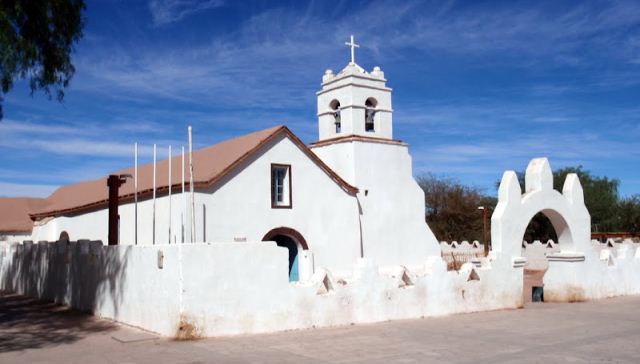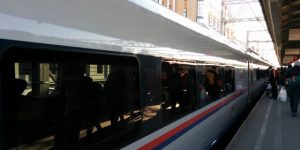
San Pedro de Atacama Church
After driving over a 5200m pass and what seemed like over a hundred kilometres of no-man’s land between Argentina and Chile, the bus pulled up at the customs office on the outskirts of San Pedro de Atacama. The driver guided us through the process then sent us into the office. We emerged to find all our bags piled up in the dust so picked everything up and walked the remaining mile or so into town.
San Pedro (de Atacama) is a small dusty village at the edge of the Atacama Desert – reputedly the driest place on Earth. Because of the combination of heat and mountains it’s thought to have not rained for over 12,000 years. Parts of the desert are known to be devoid of moisture and therefore all life, even bacteria. The lack of airborne water and minimal population leads to it having some of the clearest skies in the world, hence the abundance of huge observatories as they can stargaze all year round.
The combination of altitude and heat means we need to drink between 5 and 6 litres of water a day, which is actually quite hard work. Altitude sickness is also a concern – it can strike down anyone at any time, whether you’ve had it before or not, with no regard to age or fitness. The only method of prevention is to acclimatise slowly (i.e. don’t get the bus straight up to 5,200m or 17,000ft…) and eat small meals of plain food. This ensures the blood isn’t busy digesting red meat, alcohol or dairy products and can carry on supplying oxygen round the body. It can be fatal if the brain doesn’t get enough oxygen so if you start feel queasy or dizzy the only solutions are to take oxygen directly or descend as rapidly as possible.
With all this in mind we went for a nice red steak covered in Roquefort cheese sauce and a glass of wine. Despite the remoteness the range of restaurants in this town are of an extremely high quality and surprisingly cheap given that everything is brought in from elsewhere.
The next day we took a full day tour of the area, starting at the salt flats. These are lakes that have dried out over thousands of years to leave a salty crust. The salt flats here aren’t actually that flat, or salt. Instead it’s in crystalline formations called flowers, which contain a number of minerals the most valuable of which is Lithium. Used in rechargeable batteries, this is expected to become a major source of income for Chile over the next few years.
Just alongside the salt flats are a number of small lagoons, so it’s not that dry here. These are home to flocks of flamingos and the less impressive 1cm long brine shrimp. This all made an outstanding backdrop for the provided breakfast.
Next we visited a village of just 120 people, who apparently needed two churches – one for weekly worship and one for special occasions. They didn’t have a school, electricity, telephones, shops or medical facilities but instead paid to build a spare church so detailed it’s now got protected status.
Next up was a slightly pointless visit to see two lagoons on top of a mountain, formed from the runoff from the snow – that would be snow in the driest desert on earth again. The lakes weren’t too impressive but the walk between the two was our first bit of strenuous exercise at 4500m and thankfully we all got through it without even getting too out of breath. Other than something about frogs the most interesting fact I learnt on the way was that Chile has 1500 volcanoes, 10% of the total number worldwide.
The next lake, called Salar de Aguas Calientes was the last remnants of a prehistoric glacier and filled with minerals, hence the hazy blue colour. This was more visually appealing and the strong winds made the walk round very bracing. In a small natural amphitheatre we stopped for a decent lunch then had to make the long drive back. Just before reaching San Pedro we stopped in Tucoman, another small village of 550 people. This is home to a spring with a complicated irrigation system that makes it the home to all the regions limited agriculture – mostly corn and quinoa, a small flavourless grain frequently used as a side dish.
That evening was a highlight – we visited a French astronomer at his home in the desert. He had seven telescopes pointed at a variety of objects in the night sky. After an introductory talk explaining how the sky rotates and why the Atacama is so perfect for star gazing we got to see Mars and Saturn, which looked a little too perfect, like he’d stuck a picture on the end of a cardboard tube. Next up was the double star of Alpha Centauri and a star ‘globule’, a dense cluster of stars that looked like a Christmas tree decoration. Looking at a nebula cloud was very impressive, as was a cluster of multicoloured stars. The moon was at about three quarters, which obscured the Milky Way somewhat, but did allow us to use the telescopes to take a reasonably detailed photo of the moon with my rubbish camera.
The next day we boarded another small van to visit the driest parts of the desert, so hopefully no more lakes or snow here. First up was the seemingly appropriately named Death Valley. The first Spanish explorers here had called it Valle de Mars, due to the barren red rock. Somewhere along the way this got mispronounced as Valle de Muerte, or Valley of Death, and the name stuck. The wind here was fierce and those that had worn hats to protect them from the sun promptly lost them into the depths of the crevasse.
Next was Moon Valley, named after it’s resemblance to the surface of the moon owing to the stratifications in the rock, and the complete absence of flora and fauna, not even flamingos.
From here you can see a number of ranges of mountains including the Cordillera de la Sal (Salt Mountain Range) and the Altiplano of the Andes. Amongst these are a number of volcanoes such as Aguas Calientes which we’d climbed the previous day, and the highest called Acamarachi at 6046 meters above sea level.
Further into the park we visited a rock formation known as the Three Maries, after their vague resemblance to a mother holding a baby. Just down the road from here we climbed a large sand dune, then made our way along a narrow precipice to reach the end of a long ridge. Here we sat and after getting our breath back watched the sun set over the Andes. They started grey, but as the sun went down became a deep red, whilst the sky went from blue to purple to red.
The next day was spent shopping for supplies and preparing for the possibly quite stupid Top Gear type thing we were going to do next, take a 4×4 and drive in a straight line from here, through the desert to the middle of Bolivia.






Super-Duper blog! I am loving it!! Will be back later to read some more. I am bookmarking your feeds also.